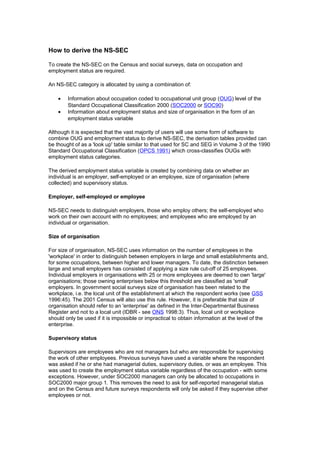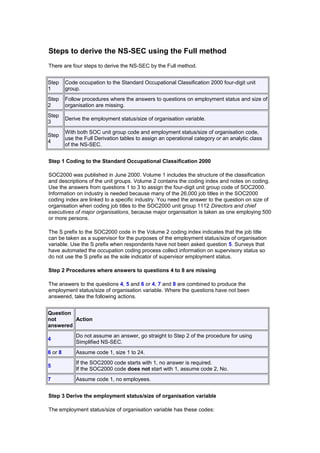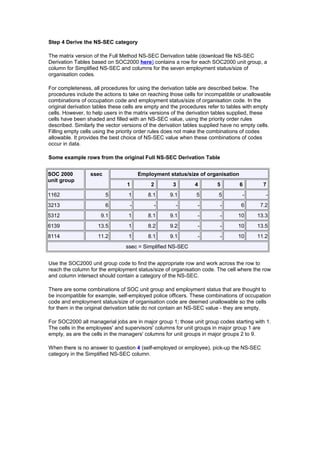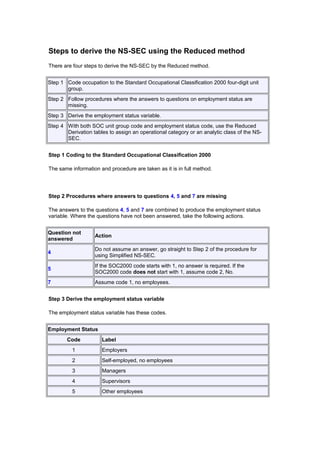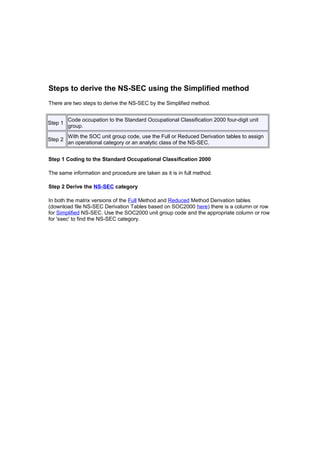Nssecdetails (1)
- 1. The National Statistics Socio-economic Classification** Introduction From 2001 the National Statistics Socio-economic Classification (NS-SEC) will be used for all official statistics and surveys. It will replace Social Class based on Occupation (SC, formerly Registrar General's Social Class) and Socio-economic Groups (SEG). This change has been agreed by the National Statistician following a major review of government social classifications commissioned in 1994 by the Office of Population Censuses and Surveys (now the Office for National Statistics) and carried out by the Economic and Social Research Council. The NS-SEC is an occupationally based classification but has rules to provide coverage of the whole adult population. The information required to create the NS-SEC is occupation coded to the unit groups (OUG) of the Standard Occupational Classification 2000 (SOC2000) and details of employment status (whether an employer, self-employed or employee; whether a supervisor; number of employees at the workplace). Similar information was previously required for SC and SEG. The version of the classification, which will be used for most analyses (the analytic version), has eight classes, the first of which can be subdivided. The National Statistics Socio-economic Classification Analytic Classes 1 Higher managerial and professional occupations 1.1 Large employers and higher managerial occupations 1.2 Higher professional occupations 2 Lower managerial and professional occupations 3 Intermediate occupations 4 Small employers and own account workers 5 Lower supervisory and technical occupations 6 Semi-routine occupations 7 Routine occupations 8 Never worked and long-term unemployed For complete coverage, the three categories Students, Occupations not stated or inadequately described, and not classifiable for other reasons are added as 'Not classified'. Researchers in ONS have developed a self-coded version of the NS-SEC which is suitable for use in situations such as postal surveys where the collection and coding of detailed occupation information is not justified.
- 2. NS-SEC Categories, Sub-Categories and Classes The National Statistics Socio-economic Classification (NS-SEC) is a flexible and nested, occupationally based classification. âĒ It may be derived in three ways (full, reduced and simplified), depending of the level of detail of employment status information available. These different methods allow the NS-SEC to be applied to registration and other administrative data, Census data and survey data - and to data of varying robustness. âĒ It is nested so that the operational categories offer users maximum flexibility in terms of different possible and allowable collapses (within the underlying conceptual model of employment relations) to eight, five and three category analytic variables. See NS- SEC classes and collapses for more information on these collapsed versions. âĒ Although occupationally based, there are procedures for classifying the non- employed to the NS-SEC. The table on the next page presents the analytic classes together with the fourteen functional and three residual operational categories of the NS-SEC. The functional categories represent a variety of labour market positions and employment statuses. These can be collapsed into the analytic versions of the NS-SEC as shown. L14 is an optional category while L15, L16 and L17 are the residual categories that are excluded when the classification is collapsed into classes. All of the operational sub-categories are the components required for bridging and continuity in relation to SC and SEG, rather than necessary categories in terms of the conceptual base of the NS-SEC. A detailed description of these categories and sub- categories is given in Detailed category descriptions and operational issues.
- 3. How to derive the NS-SEC To create the NS-SEC on the Census and social surveys, data on occupation and employment status are required. An NS-SEC category is allocated by using a combination of: âĒ Information about occupation coded to occupational unit group (OUG) level of the Standard Occupational Classification 2000 (SOC2000 or SOC90) âĒ Information about employment status and size of organisation in the form of an employment status variable Although it is expected that the vast majority of users will use some form of software to combine OUG and employment status to derive NS-SEC, the derivation tables provided can be thought of as a 'look up' table similar to that used for SC and SEG in Volume 3 of the 1990 Standard Occupational Classification (OPCS 1991) which cross-classifies OUGs with employment status categories. The derived employment status variable is created by combining data on whether an individual is an employer, self-employed or an employee, size of organisation (where collected) and supervisory status. Employer, self-employed or employee NS-SEC needs to distinguish employers, those who employ others; the self-employed who work on their own account with no employees; and employees who are employed by an individual or organisation. Size of organisation For size of organisation, NS-SEC uses information on the number of employees in the 'workplace' in order to distinguish between employers in large and small establishments and, for some occupations, between higher and lower managers. To date, the distinction between large and small employers has consisted of applying a size rule cut-off of 25 employees. Individual employers in organisations with 25 or more employees are deemed to own 'large' organisations; those owning enterprises below this threshold are classified as 'small' employers. In government social surveys size of organisation has been related to the workplace, i.e. the local unit of the establishment at which the respondent works (see GSS 1996:45). The 2001 Census will also use this rule. However, it is preferable that size of organisation should refer to an 'enterprise' as defined in the Inter-Departmental Business Register and not to a local unit (IDBR - see ONS 1998:3). Thus, local unit or workplace should only be used if it is impossible or impractical to obtain information at the level of the enterprise. Supervisory status Supervisors are employees who are not managers but who are responsible for supervising the work of other employees. Previous surveys have used a variable where the respondent was asked if he or she had managerial duties, supervisory duties, or was an employee. This was used to create the employment status variable regardless of the occupation - with some exceptions. However, under SOC2000 managers can only be allocated to occupations in SOC2000 major group 1. This removes the need to ask for self-reported managerial status and on the Census and future surveys respondents will only be asked if they supervise other employees or not.
- 4. Managers In SOC2000, managers are coded to major group 1 only (see Elias et al. 2000 for a fuller explanation). Thus in the original derivation tables the managerial cells are only valid for SOC2000 codes 1111 to 1239 while for these codes the cells for other employees (including supervisors) are left blank. For SOC2000 major groups 2 to 9 the managerial codes are not valid, as managers in these occupations should be coded to major group 1 and, therefore, the managerial cells are left blank in the original derivation tables. Blank cells There are other blank cells in the original derivation tables which correspond to situations deemed not to arise, such as a self-employed police officer. In practice some responses to surveys and censuses may correspond to blank cells (e.g. as a result of coding error). In previous Census and survey practice these were edited according to rules by either changing the occupation or the employment status code so as to achieve an allowable combination. While such editing can correct coding or keying errors, it could also be the case that the original derivation tables do not allow for combinations that do appear in the real world. This can especially be the case for occupations where self-employment is deemed not to occur but where labour market changes have nevertheless created a new combination. Three derivation methods There are three methods to derive the functional categories L1 to L13 of the NS-SEC. The choice of method depends on the information gathered about employment status. Method Information required Full SOC2000 unit group, employment status, size of organisation Reduced SOC2000 unit group, employment status Simplified SOC2000 unit group The Reduced method was developed for sources unable to collect information on size of organisation. The Simplified method provides a last resort solution; if used on its own no records will be allocated to the first category of the classification. At the eight-class level the reduced method correctly allocates 98 per cent of cases compared to the Full method. The Simplified method correctly allocates 83 per cent of cases compared to the Full method.
- 5. Steps to derive the NS-SEC using the Full method There are four steps to derive the NS-SEC by the Full method. Step Code occupation to the Standard Occupational Classification 2000 four-digit unit 1 group. Step Follow procedures where the answers to questions on employment status and size of 2 organisation are missing. Step Derive the employment status/size of organisation variable. 3 With both SOC unit group code and employment status/size of organisation code, Step use the Full Derivation tables to assign an operational category or an analytic class 4 of the NS-SEC. Step 1 Coding to the Standard Occupational Classification 2000 SOC2000 was published in June 2000. Volume 1 includes the structure of the classification and descriptions of the unit groups. Volume 2 contains the coding index and notes on coding. Use the answers from questions 1 to 3 to assign the four-digit unit group code of SOC2000. Information on industry is needed because many of the 26,000 job titles in the SOC2000 coding index are linked to a specific industry. You need the answer to the question on size of organisation when coding job titles to the SOC2000 unit group 1112 Directors and chief executives of major organisations, because major organisation is taken as one employing 500 or more persons. The S prefix to the SOC2000 code in the Volume 2 coding index indicates that the job title can be taken as a supervisor for the purposes of the employment status/size of organisation variable. Use the S prefix when respondents have not been asked question 5. Surveys that have automated the occupation coding process collect information on supervisory status so do not use the S prefix as the sole indicator of supervisor employment status. Step 2 Procedures where answers to questions 4 to 8 are missing The answers to the questions 4, 5 and 6 or 4, 7 and 8 are combined to produce the employment status/size of organisation variable. Where the questions have not been answered, take the following actions. Question not Action answered Do not assume an answer, go straight to Step 2 of the procedure for using 4 Simplified NS-SEC. 6 or 8 Assume code 1, size 1 to 24. If the SOC2000 code starts with 1, no answer is required. 5 If the SOC2000 code does not start with 1, assume code 2, No. 7 Assume code 1, no employees. Step 3 Derive the employment status/size of organisation variable The employment status/size of organisation variable has these codes:
- 6. Employment status/size of organisation Code Label 1 Employers - large organisations 2 Employers - small organisations 3 Self-employed, no employees 4 Managers - large organisations 5 Managers - small organisations 6 Supervisors 7 Other employees Use the answers, or assumed answers to questions on employment status/size of organisation and the SOC2000 unit group code to derive one of the seven codes. A standard flow chart view of the process is available below:
- 7. Step 4 Derive the NS-SEC category The matrix version of the Full Method NS-SEC Derivation table (download file NS-SEC Derivation Tables based on SOC2000 here) contains a row for each SOC2000 unit group, a column for Simplified NS-SEC and columns for the seven employment status/size of organisation codes. For completeness, all procedures for using the derivation table are described below. The procedures include the actions to take on reaching those cells for incompatible or unallowable combinations of occupation code and employment status/size of organisation code. In the original derivation tables these cells are empty and the procedures refer to tables with empty cells. However, to help users in the matrix versions of the derivation tables supplied, these cells have been shaded and filled with an NS-SEC value, using the priority order rules described. Similarly the vector versions of the derivation tables supplied have no empty cells. Filling empty cells using the priority order rules does not make the combinations of codes allowable. It provides the best choice of NS-SEC value when these combinations of codes occur in data. Some example rows from the original Full NS-SEC Derivation Table SOC 2000 ssec Employment status/size of organisation unit group 1 2 3 4 5 6 7 1162 5 1 8.1 9.1 5 5 - - 3213 6 - - - - - 6 7.2 5312 9.1 1 8.1 9.1 - - 10 13.3 6139 13.5 1 8.2 9.2 - - 10 13.5 8114 11.2 1 8.1 9.1 - - 10 11.2 ssec = Simplified NS-SEC Use the SOC2000 unit group code to find the appropriate row and work across the row to reach the column for the employment status/size of organisation code. The cell where the row and column intersect should contain a category of the NS-SEC. There are some combinations of SOC unit group and employment status that are thought to be incompatible for example, self-employed police officers. These combinations of occupation code and employment status/size of organisation code are deemed unallowable so the cells for them in the original derivation table do not contain an NS-SEC value - they are empty. For SOC2000 all managerial jobs are in major group 1; those unit group codes starting with 1. The cells in the employees' and supervisors' columns for unit groups in major group 1 are empty, as are the cells in the managers' columns for unit groups in major groups 2 to 9. When there is no answer to question 4 (self-employed or employee), pick-up the NS-SEC category in the Simplified NS-SEC column.
- 8. Steps to derive the NS-SEC using the Reduced method There are four steps to derive the NS-SEC by the Reduced method. Step 1 Code occupation to the Standard Occupational Classification 2000 four-digit unit group. Step 2 Follow procedures where the answers to questions on employment status are missing. Step 3 Derive the employment status variable. Step 4 With both SOC unit group code and employment status code, use the Reduced Derivation tables to assign an operational category or an analytic class of the NS- SEC. Step 1 Coding to the Standard Occupational Classification 2000 The same information and procedure are taken as it is in full method. Step 2 Procedures where answers to questions 4, 5 and 7 are missing The answers to the questions 4, 5 and 7 are combined to produce the employment status variable. Where the questions have not been answered, take the following actions. Question not Action answered Do not assume an answer, go straight to Step 2 of the procedure for 4 using Simplified NS-SEC. If the SOC2000 code starts with 1, no answer is required. If the 5 SOC2000 code does not start with 1, assume code 2, No. 7 Assume code 1, no employees. Step 3 Derive the employment status variable The employment status variable has these codes. Employment Status Code Label 1 Employers 2 Self-employed, no employees 3 Managers 4 Supervisors 5 Other employees
- 9. Use the answers, or assumed answers to questions on employment status and the SOC2000 unit group code to derive one of the five codes. A standard flow chart view of the process is available below. Step 4 Derive the NS-SEC category The matrix version of the Reduced Method NS-SEC Derivation table (download file NS-SEC Derivation Tables based on SOC2000 here) contains a row for each SOC2000 unit group, a column for Simplified NS-SEC and columns for the five employment status codes.
- 10. Steps to derive the NS-SEC using the Simplified method There are two steps to derive the NS-SEC by the Simplified method. Code occupation to the Standard Occupational Classification 2000 four-digit unit Step 1 group. With the SOC unit group code, use the Full or Reduced Derivation tables to assign Step 2 an operational category or an analytic class of the NS-SEC. Step 1 Coding to the Standard Occupational Classification 2000 The same information and procedure are taken as it is in full method. Step 2 Derive the NS-SEC category In both the matrix versions of the Full Method and Reduced Method Derivation tables (download file NS-SEC Derivation Tables based on SOC2000 here) there is a column or row for Simplified NS-SEC. Use the SOC2000 unit group code and the appropriate column or row for 'ssec' to find the NS-SEC category.
- 11. Derivation tables The derivation tables are available in various formats. (Cells for unallowable combinations of codes have been filled using the priority order rules and are shaded.) âĒ Matrix format Arranges the combinations of SOC codes and Employment Status codes in a matrix. âĒ Vector format Arranges the combinations of SOC codes and Employment Status codes in a vector. This format is easier for use in statistical packages such as SPSSÂŪ, SASÂŪ or STATAÂŪ. A warning on statistical software The derivation tables contain values with decimal places that relate to the operational sub- categories (i.e. 3.1, 3.2, etc). Using the tables in most statistical software can result in some precision problems if the variables are defined as numeric and used in calculations. It is recommended to define the NS-SEC variables as nominal. Tables for deriving NS-SEC based on SOC90 Derivation table for the Full Method - NS-SEC Operational Categories âĒ Matrix format in Excel (Fm90oc.xls) (71Kb excel worksheet) âĒ Matrix format in tab-delimited text file (Fm90oc.rtf) (69Kb rich text format) âĒ Vector format in tab-delimited text file (F90vecoc.txt) (53Kb text file) The content of the matrix table is described in this file Fm90ocsp.doc (39Kb word file) The content of the vector table is described in this file F90vecsp.doc (38Kb word file) Derivation table for the Full Method - NS-SEC Analytic Classes âĒ Matrix format in Excel (Fm90ac.xls) (71Kb excel worksheet) âĒ Matrix format in tab-delimited text file (Fm90ac.rtf) (65Kb rich text format) The content of the matrix table is described in this file Fm90acsp.doc (44Kb word file) Derivation table for the Reduced & Simplified Method - NS-SEC Operational Categories âĒ Matrix format in Excel (Rm90oc.xls) (71Kb excel worksheet) âĒ Matrix format in tab-delimited text file (Rm90oc.rtf) (60Kb rich text format) âĒ Vector format in tab-delimited text file (R90vecoc.txt) (40Kb text file) The content of the matrix table is described in this file Rm90ocsp.doc (38Kb word file) The content of the vector table is described in this file R90vecsp.doc (37Kb word file) Derivation table for the Reduced & Simplified Method - NS-SEC Analytic Classes
- 12. âĒ Matrix format in Excel (Rm90ac.xls) (84Kb excel worksheet) âĒ Matrix format in tab-delimited text file (Rm90ac.rtf) (57Kb rich text format) The content of the matrix table is described in this file Rm90acsp.doc (42Kb word file) Alternatively, users can use NSSEC90.dta to derive SSEC, RSEC, SSEC7 and RSEC7 using soc90 and employment status for pre-2001 data sets.



